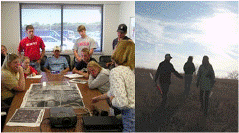Environmental Studies Program
Date of this Version
Fall 2015
Citation
Environmental Studies Undergraduate Student Thesis, University of Nebraska–Lincoln, 2015
Abstract
The purpose of my thesis research is to examine blue green algae and land use trends across Nebraska using GIS technology in order to create a map that demonstrates any correlation between the data. Much research has already been conducted linking agricultural practices to eutrophication and I believe that upon examination of the data, that most of the water bodies containing high levels of blue green algae will be closely related to areas in high agricultural production. Specifically, I hypothesize that areas with a lot of corn production will see the most blue green algae blooms. I will use the Nebraska Department of Environmental Quality blue green algae data from 2008-2015 in combination with the GIS technologies to create a map. This map will demonstrate my results that either support or disprove my hypothesis. This map will also serve to identify other land use trends that may influence eutrophication on many Nebraska lakes, rivers, and streams. I will then attempt to identify ways can we mitigate to keep Nebraska lakes from being affected by algal blooms while still conducting the present land use trend? I will attempt to address how farming attitudes, methods, and education contribute to the eutrophication of lakes and streams and how these aspects may directly effect water quality.
Eutrophication of Nebraska water bodies can have harmful and adverse effects on the environment as well as humans. Algal blooms are a major cause for summer fish kills. Excess nutrients make their way into a water body and cause a drastic increase in organic matter in the water. When the algae decompose, it can cause a decrease in oxygen levels and organisms such as fish can die. This has been an apparent concern with the eutrophication of coastal waters around the confluence of the Mississippi river and Gulf of Mexico. (EPA) When blue green algae gets above 20 ppb (NDEQ), it can become dangerous for humans and animals to come into close contact with the water. (Nebraska Department of Environmental Quality) Hopefully my research can help provide a visual diagram to recreationalists and enthusiasts alike who are interested in knowing which water bodies across Nebraska are commonly affected by algal blooms.


Comments
Copyright @ 2015 Matt O'Nele